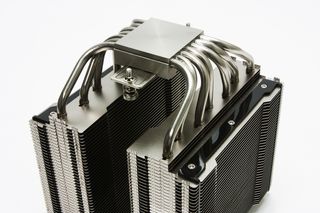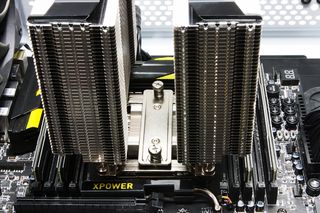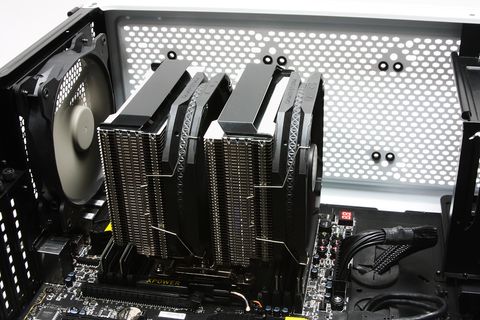Tom's Hardware Verdict
The Deepcool Gamer Storm Assassin III should be on every enthusiast and HEDT system builder’s colling short list. With seven copper heatpipes and twin 140mm cooling fans, it provides excellent thermal performance at a competitive price of $90.
Pros
- +
Excellent thermal performance
- +
Simple installation
- +
Sharp design, sans lighting
Cons
- -
Expensive for an air cooler
- -
Slightly higher noise levels than competitors
Why you can trust Tom's Hardware
With continued focus on high-end desktop (HEDT) and enthusiast CPUs, the battle of processor cores and overall performance supremacy between AMD and Intel is alive and well. But with higher core counts and clock speeds comes more heat generation with modern high-end chips--and there are always more promising, powerful slices of silicon on the horizon.

Enter Deepcool and its Assassin III. This big air cooler ships with a bountiful accessory set, including a long-reach magnetic screwdriver, syringe of thermal compound, spreading card, alcohol swab pad, PWM splitter cable, RPM reduction cables (x2), metal case badge and mounting hardware for most current AMD and Intel CPU sockets. The mounting hardware is nickel plated for a bright, chromed finish, which contrasts nicely with the blacked out color scheme from the fans and plastic accent pieces on the cooling tower.
Deepcool covers the Assassin III for 5 years under its heat pipe air cooler product warranty.
Specifications
| Height | 6.75" / 171.5mm |
|---|---|
| Width | 5.50" / 139.7mm |
| Depth | 5.25" / 133.4mm, (6.25" / 158.8mm w/fans) |
| Base Height | 1.50" / 38.1mm |
| Assy. Offset | Front (1.0" / 25.4mm w/fans) |
| Cooling Fans | (2) 140 x 25mm |
| Connectors | (2) 4-pin PWM |
| Weight | 42.7 oz / 1210g |
| Intel Sockets | 115x, 1366, 2011x, 2066 |
| AMD Sockets | FM2(+), FM1, AM2(+), AM3(+), AM4 |
| Warranty | 5 years |
| Web Price | $90 |
Features

Seven heatpipes account for the bulk of the cooling prowess of the Assassin III, each which are nickel plated and run the entire height of both cooling towers. The cooling fin stack provides enough density of fins to assure good heat displacement, while a partially vented side skirt to allows some air dissipation laterally, without negating the ducting effect of airflow through the structure.
The Assassin III uses a fixed torsion plate atop the cooling base, which is then affixed with tension screws to the mounting plate cross bars during installation. Having this torsion plate permanently attached smartly prevents misalignment of the large cooler as it is installed.

Airflow through the Assassin III is made possible by a pair of Deepcool GamerStorm TF-140S fans rated up to 1400 RPM (+/- 10%) at full speed. The fan blades have what resembles trailing-edge ducting arches on each blade while sporting a satin finish. Rubber isolation grommets adorn each corner around the mounting holes.
A pair of glossy black spoilers sit atop the cooler on each fin stack. These exist solely as decorative covers for the tips of the pinched and soldered heatpipes, but do provide aesthetic contrast to the polished nickel plating.
Both fans are installed to the cooling tower using wire spring clips; one fan moves air through the front of the first cooling tower, and another situated in the center moves air front-to-rear on the second tower. Only two sets of wire clips are shipped with the cooler, so those hoping to add a third fan at the rear of the cooler should be prepared to bring some DIY spirit.

The base of the Assassin III is made up of multiple pieces, where the collection of the seven heatpipes is sandwiched between the base mounting block and the base plate itself. This allows for the base plate to be machined precisely, while avoiding any milling issues and abnormalities from the heatpipes themselves, as would happen in a direct-contact arrangement.
The tension spring screws and torsion mounting bar are easily seen from this orientation, as are the partially ducted side fins along both cooling tower sides. The black plastic runner bars at the base of the cooler are mounting points for the black spoiler pieces covering the heatpipe tips. These spoilers have arms running down the front and rear faces of the cooler between fin cutouts, and are secured with small hex screws under the fin stack.

Installation of the Deep Cool Assassin III is relatively straightforward, and depending on whether your system will need to make use of the included backplate, the rest of the cooler mounting follows the same procedure. The transverse mounting bars support the base’s fixed torsion bar. Align these spring tension screws over the threaded holes and secure with the included screwdriver.

Fan installation only requires slipping the wire clips into the eyes of the rubberized mounting holes and clipping them around each side of the cooler heatpipe towers. The fan clips allow for vertical adjustment of the cooling fans. Although most memory DIMMs should have little issue with clearance, extreme fan height adjustment may result in diminished airflow over the lower cooling fins. So avoid RAM with tall heat spreaders if you want the best CPU cooling performance.
MORE: Best CPU Cooling
MORE: How To Choose A CPU Cooler
MORE: All Cooling Content
- 1
- 2
Current page: Features and Specifications
Next Page Comparison Coolers, Testing Results and Conclusion
Garrett Carver is a contributor for Tom’s Hardware, primarily covering thermal compound comparisons and CPU cooling reviews; both air and liquid, including multiple variations of each.
-
rickmeister The Noctua NH-D15 is The same price (Amazon) as the Assassin III. It has 140mm fans and seems to be a better heads up comparison to the Assassin III. Why wasn't it included in the test?Reply -
msc545 Why in god's name would someone choose a huge, ungainly air cooler over an AIO. The price difference is not that significant.Reply -
Darkbreeze Probably because they don't have any NH-D15 test results on the same test platform that this test was conducted on. Since I believe they've created a newer, more standardized test platform at some point it is likely that there has not been a test of the D15 since doing so. I don't know for sure that that is the reason, but that would be my guess.Reply
Obviously, a comparison of other twin finstack coolers would seem a lot more appropriate but not if the comparison cannot be done using the same test platform. That would just make it pointless. -
Darkbreeze Replymsc545 said:Why in god's name would someone choose a huge, ungainly air cooler over an AIO. The price difference is not that significant.
There are MANY reasons why.
More expensive.
Doesn't particularly cool better unless you go with a very large AIO. 280mm is just about a requirement if you want to beat a twin finstack 140mm cooler.
AIO is louder. In some cases, MUCH louder, especially if you factor in pump noise.
Air coolers don't leak. And if you think AIO leakage is uncommon, you haven't been around them, or here, very often.
AIO coolers last, on average, about three years before pump failures force you to replace the whole cooler. Air coolers, you might have to replace a fan every six to ten years, maybe. If you keep the heatsink cleaned regularly and have intake filtration, you may not need to replace the fan for longer than that. And even if you do, 25 bucks for a good high end fan is a lot easier to swallow than another 100-160 bucks for a replacement AIO unit. In some cases, especially on cheaper AIO units, they pump may not even last that long. We've seen a number of units that barely made it out of warranty, or didn't even make it out of warranty.
An AIO is not like a custom open loop. It is not ever going to give you that kind of water cooled performance. AIO units main appeal is aesthetics, not pure performance. If you like the look, then there is much to be said for them. Otherwise, unless you go with a very good 280, 360 or 420mm cooler, you're not really going to gain anything in terms of performance over a big air cooler. -
msc545 I disagree at least in part. AIO's are in the same price range (75-150) as air coolers, and adjusted properly, they cool much better than air coolers.Reply
There is no way that an AIO pump is noisier than an air coolers fan(s). I've had AIO coolers going continuously for about 4 years now with no leaks or failures, although I admit a leak is something of major concern.
The best things about AIO coolers is 1) they fit in the case; 2) they are quiet); 3) they don't accumulate dust in the same way air coolers do and are easier to clean; 4) they cool better; 5) they don't weigh so much as to distort sockets and motherboards, which some air coolers do; 6) you don't have to remove an AIO to transport a computer in the upright position. -
Virtual_Singularity Reply
Risk of leakage, corrosion, pump probs, etc inherent with AIO water coolers & even costly closed loops, only grow with time. That some water AIOs are beaten by air coolers, or the cost of some AIO's being expensive vs air coolers for negligible results is also weighed (sry for pun) by many consumers when making their choice.msc545 said:Why in god's name would someone choose a huge, ungainly air cooler over an AIO. The price difference is not that significant.
Valid question for sure, but not surprised at all the D-15 wasn't included here. I'd bet the Deepcool is likelyrickmeister said:The Noctua NH-D15 is The same price (Amazon) as the Assassin III. It has 140mm fans and seems to be a better heads up comparison to the Assassin III. Why wasn't it included in the test?
better or similar to the stock D-15, and in another test chart from another site it showed just that, though not by much. I know this prolly won't be too helpful, but fwiw my experience showed the newer, more compact NH-U12A slightly beating/on par with the D-15. Tho depending on processor type, size, load under OC, ambient temps, and many other variables, it's really always a toss up in re to charts, when it comes to temps most of all. -
Darkbreeze Reply
Nobody said the pump alone was noisier. You want to run your AIO with just the pump? I didn't think so.msc545 said:There is no way that an AIO pump is noisier than an air coolers fan(s).
The noise levels for practically any 240-420mm AIO is always going to be louder if you factor in not only the two fans that will be running but the addition of pump noise as well. Even coolers with two fans on the heatsink are typically quieter because unlike an AIO they are buried inside the case rather than being faced directly against an opening to the outside. It's really no different that taking an alarm clock that is ringing and putting it in a box. Sure, you can still hear it, but it's going to be quieter than it was before.
This is obviously not directly comparable but it is in fact representative of what you'll find, across the board, doing similar comparisions. Note that practically every AIO except the Floe Ring 360 is louder than the nine air coolers in the comparison. And the Floe Ring is a 360mm so clearly it can run it's fans a bit slower while still maintaining fairly decent performance since it has a lot more surface area AND an additional fan.
Overall, AIO coolers are much noisier, with 50-60db not being uncommon under load. Sure, you can tune them for quieter operation but you are going to lose a significant amount of performance that way. By comparison, The NH-U14S or NH-D15 can be run at full speed fans and with a decent case the noise levels are low enough to be conversational. Spin it however you like, complain about the full speed 12v operation, the fact remains that most AIO coolers are going to have significantly louder cumulative noise levels with it's two fans and pump than an air cooler is. At least if it is a decent quality cooler with good quality fans.
And I don't ever have to check to see if the damn thing has ruined my hardware today or not. Nor do I have to guess if my thermal issues are due to a bad pump. Nor will it cost me another 120 bucks when something does go wrong with my cooler.
-
PapaCrazy Replymsc545 said:Why in god's name would someone choose a huge, ungainly air cooler over an AIO. The price difference is not that significant.
Everyone's raised good points. I'd just like to point out the risk for single point catastrophic failure is much higher due to increased complexity.
Single point of failure worst case scenario air cooled: One of the two push-pull fans blows a bearing. You chug along with one fan at higher temps. CPU throttles slightly. Maybe you get really unlucky and even the second fan breaks. You still have a large heat sink. It cannot fail. Redundancy in cooling. More throttling, but CPU chugs along. Fans can be replaced same day without removal of entire system.
Single point of failure worst case scenario water cooled: Pump breaks, and water sits still over the CPU block like a thermal blanket. CPU temps continue to increase, despite attempts to throttle. TJ Maxx of 100c is boiling point for water. Fluid near the CPU block cannot distribute its heat, climbing toward 100c and increasing pressure inside the tubes. Pressure causes tubes to rupture, hosing down motherboard and GPU. Things suck for a while. -
rickmeister ReplyVirtual_Singularity said:Valid question for sure, but not surprised at all the D-15 wasn't included here. I'd bet the Deepcool is likely
better or similar to the stock D-15, and in another test chart from another site it showed just that, though not by much. I know this prolly won't be too helpful, but fwiw my experience showed the newer, more compact NH-U12A slightly beating/on par with the D-15. Tho depending on processor type, size, load under OC, ambient temps, and many other variables, it's really always a toss up in re to charts, when it comes to temps most of all.
The U12A may keep up at lower TDPs but my 8700K ran 12C cooler with the D-15 over the U12A and it took longer to saturate the cooler. Recovery time was better on the U12A. -
rubix_1011 The NH-D15 has not been tested on this platform; DarkBreeze is correct. It's an older cooler and I haven't been sent one from Noctua to test. The be quiet! Dark Rock Pro 4 is one of the largest/newer coolers I've covered and have normalized test data for. Since I took over the cooler reviews a few years ago, the platform needed to be re-benched and we needed a new place to start. I apologize for not having that data for comparison, but allow me to explain.Reply
The NH-D15, while being excellent for its age, was likely covered before the period when I had the test bench setup. I don't have access to every cooler available - I only have test data on coolers which have been supplied by vendors to be evaluated and get coverage on the site. I have actually asked Noctua for an NH-D15 sample that I can test and use for reference and while new models are often the priority, sometimes getting older components takes longer to get responses - hopefully I'll get one soon, I really would like to do a larger round-up article on large air coolers vs. AIOs, so it's rather ironic this conversation is taking place here.
To address other points of big air vs AIOs: Honestly, I'd personally rather have a larger air cooler than an AIO at the same price, and I'm a custom watercooling guy of more than 18 years. I do have some newer AIOs that are in my queue to be evaluated that are incredibly good looking, though.
While AIOs have gotten far better in recent times, quality air cooling has also come a VERY long way in the same period while also still remaining immune to the biggest fear most PC tech forums face: 'leaks'.
Most big air coolers are also nearly silent, or at least quieter than closed loop liquid cooling. The same cannot be said for a 240mm AIO...go compare the dbA on my test comparisons.

